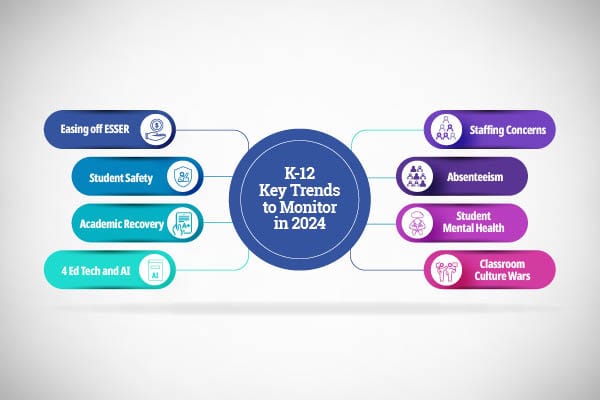The nation’s schools face numerous challenges as 2024 ramps up, according to an article in K-12 Dive.
Here are eight trends to keep an eye on:
1) Easing off ESSER
The first and second rounds of Elementary and Secondary Emergency Relief (ESSR) funding are closed, but schools can still spend ESSER III funds until September 30, 2024. While schools have to obligate funds by Sept. 30, they can continue to use funds until Jan. 28, 2025. Schools can also receive extensions for up to 14 months after the January deadline with approval from the Department of Education.
As school systems transition to more normal cash flows, leaders are asking questions around concerns including whether staff layoffs are needed, if summer programming should be pared back, and how both learning and mental health initiatives can be preserved.
Still, others with large allocations left over may have to plan for a frenzy of spending. Otherwise, unspent funds will revert to the federal government.
The winding down of ESSER alongside falling student enrollments and slowing state revenues could lead to ”a perfect storm of financial chaos,” for K-12 schools, wrote Marguerite Roza, director of Edunomics Lab, and Katherine Silberstein, research fellow at Edunomics Lab, in a paper posted by The Brookings Institution.
2) Protecting student safety
With last year’s record high number of mass shootings on K-12 campuses, school leaders this year will continue seeking solutions to reduce gun violence and address other school safety concerns.
District and state budget plans indicate physical investments in security at facilities, including artificial intelligence to detect guns, metal detectors, clear backpacks, secure windows and doors, and visitor vestibules.
Also expected are the development of resources and best practices for creating safe environments and addressing student behaviors and mental health needs. But there is some concern that pushback to certain approaches such as social emotional learning will stunt progress on creating safe and welcoming school climates.
Meanwhile, education leaders remain vigilant about how schools’ physical vulnerabilities factor into building design and safety plans.
3) Bolstering academic recovery
Disappointing assessments in math and reading were at the top of education conversations in 2023, but now there is more optimism among educators, parents and researchers that investments in post-pandemic academy recovery will pay off.
While many 2023 state assessment results showed students were below pre-COVID performance levels, several states recorded test score data gains compared to 2022, according to Test Score Data Briefs published by the COVID-19 School Data Hub.
With academic recovery — including investments in tutoring and the science of reading — being one of the priorities for ESSER funding, according to a McKinsey & Company article, many believe student learning outcomes will remain on the upswing.
But enrollment, particularly for the youngest students, is not yet back to pre-pandemic levels. School leaders and advocates are also raising alarms about continued struggles with absenteeism.
Additionally, if the trend toward a four-day school week continues as a way for districts to save money and recruit teachers, some worry the reduced learning time will adversely impact student achievement.
4) Ed tech grapples with AI, data privacy concerns
It’s been a little over a year since the introduction of ChatGPT, forcing schools to quickly navigate student and staff access to generative artificial intelligence tools while understanding the role AI could play in the classroom. As some school leaders and educators flagged concerns of plagiarism, others saw an opportunity to enhance student learning and teacher workflow efficiencies.
Various AI guidance for K-12 leaders has continued to roll out from various sources, but a major question remains: How will schools implement the scattered and, for now, unenforced recommendations?
AI also continues to spark concerns over student data privacy. Even before generative AI existed, students’ personal information was already vulnerable to exposure in data breaches often stemming from cyberattacks.
The severity of the issue is grabbing federal leaders’ attention, as the White House and the U.S. Education Department announced efforts in August to bolster K-12 cybersecurity. The FCC in November proposed a 3-year pilot program using $200 million in agency funds to help schools and libraries fight cybersecurity threats.
As these initiatives progress, it will be important to note this coming year if schools begin to feel that their sensitive data is truly protected and safely stored.
5) Staffing concerns persist
Like last year, comprehensive data to gauge the gravity of nationwide teacher shortages was lacking at the local, state and national level, but anecdotal evidence and research has found the issue is a persistent one.
The final ESSR spending deadline was this fall, and some school districts may have to consider laying off teachers. That’s because they are relying on federal relief funds for those positions, which could lead up to an estimated 250,000 education jobs to be potentially cut, according to Marguerite Roza, a research professor and director of the Edunomics Lab. Even so, some education experts previously noted those roles will still be needed even if they disappear after the ESSER funds run out.
Teacher salaries — a key factor in recruitment and retention — also took a hit despite the influx of federal cash to districts. A report by the Economic Policy Institute found rising inflation worsened the “teacher pay penalty” compared to other professionals. This trend has also led to teacher and staff strikes while schools grapple with finding the funds to raise salaries.
Will schools receive more resources to support and retain staff this year? Will they seek out innovative solutions? Or will they be forced to make the unfortunate, tough decision to lay off staff?
6) Growing focus on addressing chronic absenteeism
As schools persist in their post-pandemic recovery efforts, they are challenged by chronic absenteeism.
According to Attendance Works, an advocacy organization closely tracking the issue, chronic absenteeism skyrocketed to nearly 14.7 million students in the wake of COVID, with 6.5 million more students missing at least 10% of the school year in 2021-22 than prior to the pandemic.
While data pointed toward a slight decrease in 2022-23, it also showed that it’s likely the high levels remained relatively steady overall during the last school year. It’s an issue that will impact schools for at least three to four more years, according to Hedy Chang, executive director of the organization.
As schools continue to grapple with absenteeism in 2024, the White House, Education Department and education organizations have called for an “all hands on” approach.
They’ve pointed to interventions like making home visits, communicating in families’ native languages, and engaging in after- or before-school activities.
The Education Department also said in late 2023 that it would ”hold states accountable for ensuring they fulfill commitments they have made to collect chronic absenteeism data and monitor States on the interventions they use.”
7) Growing spotlight on student mental health
Closely tied to absenteeism and other challenges schools face is students’ mental health, which schools will likely continue to monitor and support as part of their COVID recovery efforts.
Teens ages 13-18 said that that their mental health, motivation, relationships with friends and overall happiness have improved since the early months of the pandemic.
Still, only a third of 1,000 teenagers polled said they feel supported by their schools when it comes to mental health, according to the survey conducted by Morning Consult, a business intelligence company, and EdChoice, a nonprofit that advocates for school choice.
And while educators and district leaders agree that student mental health has worsened since the pandemic and remains a concern, they cited budget challenges, staff shortages, and pressure to boost academic outcomes as barriers to addressing the issue.
As research suggests mental health is closely tied to academic performance, how educators support students in 2024 and beyond could have long-term implications.
8) Classroom culture wars continue
School censorship, which ramped up concerns for educators under the 1619 Project exploring the impact of slavery and contributions of Black Americans to the formation and growth of the United States, right-leaning state laws continue to vex schools nearly three years later.
With many laws restricting LGBTQ+ and race-related curriculum now in effect in conservative states, the controversy has progressed to lawsuits against school districts — and to high-profile companies coming under scrutiny — in the wake of such laws.
In 2023, Scholastic Book Fairs, the largest publisher and distributor of children’s books, came under fire from the public and educators after it created a separate collection for diverse titles in school book fairs. Similarly, the college board, which administers Advanced Placement courses, also received pushback after it made changes to its AP African American Studies curriculum, following state restrictions on race-related content.
Districts are also caught between state laws restricting curriculum on one hand, and civil rights obligations under the Constitution and federal laws like Title IX, which protects students from sex discrimination on the other.
These lawsuits will continue to work their way through the courts in 2024, and the outcomes of those cases could set the tone for how districts approach the issue and set policy going forward.
K-12 Dive




